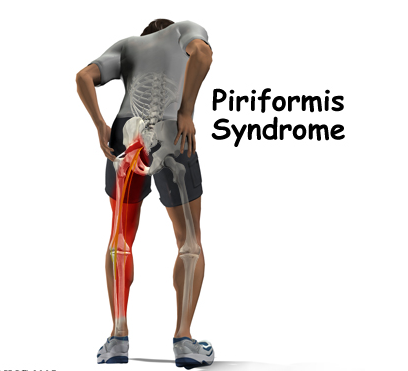Commonly confused with sciatica, piriformis syndrome causes similar pain in the lower back and buttocks that often extends down the back of the leg and into the foot. It is caused when the piriformis muscle irritates the sciatic nerve. The piriformis muscle extends from the sacrum to the outer hip bone, and is located deep in the buttock, below the gluteus maximus muscle. When the muscle becomes shortened or tightened, or if it spasms, it can become inflamed, putting pressure on the sciatic nerve that runs beneath it. In some cases (up to 10% of people) the sciatic nerve runs right through the piriformis muscle, making it particularly vulnerable to muscle spasms. The inflammation may also cause scar tissue and adhesions to form, which can trap and irritate the sciatic nerve.
The most common risk factors that may lead to the development of piriformis syndrome are activities that involve excessive weight bearing, running and changing direction. Many athletes suffer from this condition, particularly runners and weight lifters. Externally rotating the hip for extended periods of time can also lead to piriformis syndrome, something that is common among ballet dancers. If you tend to walk with your feet turned outward, this can indicate a possible source of the problem. Misalignment of the bones of the pelvis may also be involved. 
Both too much exercise and too little may contribute to piriformis syndrome. Athletes should avoid the following: training on hard concrete surfaces, increasing their workout too quickly in either duration or intensity, training on ground that is not even, and exercising in shoes that are worn or do not fit properly. Those who are sedentary should avoid beginning too strenuous an exercise routine at first, and should gradually building up endurance. Everyone should avoid sitting for long lengths of time to avoid triggering piriformis syndrome (and to keep healthy overall). If you suffer from sciatica you may want to call your Chicago Chiropractor.
The most common treatment for piriformis syndrome is exercise that involves stretching the piriformis and hamstring muscles:
Piriformis stretch – Lie on your back with legs flat on the floor and bring your right knee up toward your chest. Grip the knee with your left hand, then gently pull the knee toward your left shoulder and hold for 30 seconds. Repeat on the opposite side. If you want help with these exercises contact a chiropractor or Chicago Chiropractic.
Hamstring stretch – Again, lie on your back with both legs flat on the floor. Using a belt looped around the arch of your foot, and keeping the leg straight, raise the leg off the floor until it is perpendicular to the floor and at a slight angle toward your body, while helping by pulling on the belt. Repeat 3 to 5 times.
Other treatments include pain management using anti-inflammatory drugs, alternating ice and heat, physical therapy and electrotherapy. Only in rare cases is surgery suggested, and its results are often mixed. One of the least invasive and most effective professional treatments for piriformis syndrome is chiropractic care.
A chiropractor can use pelvic and spinal adjustments to address the misalignments that may be causing the piriformis muscle to spasm, allowing it to relax and release the trapped sciatic nerve. Your CHIROPRACTOR can also recommend additional exercises and stretches to help keep you pain-free in a way that does not require drugs or invasive procedures.
Chicago Chiropractic
A Unique, Multidisciplinary Approach to Pain Management
X
